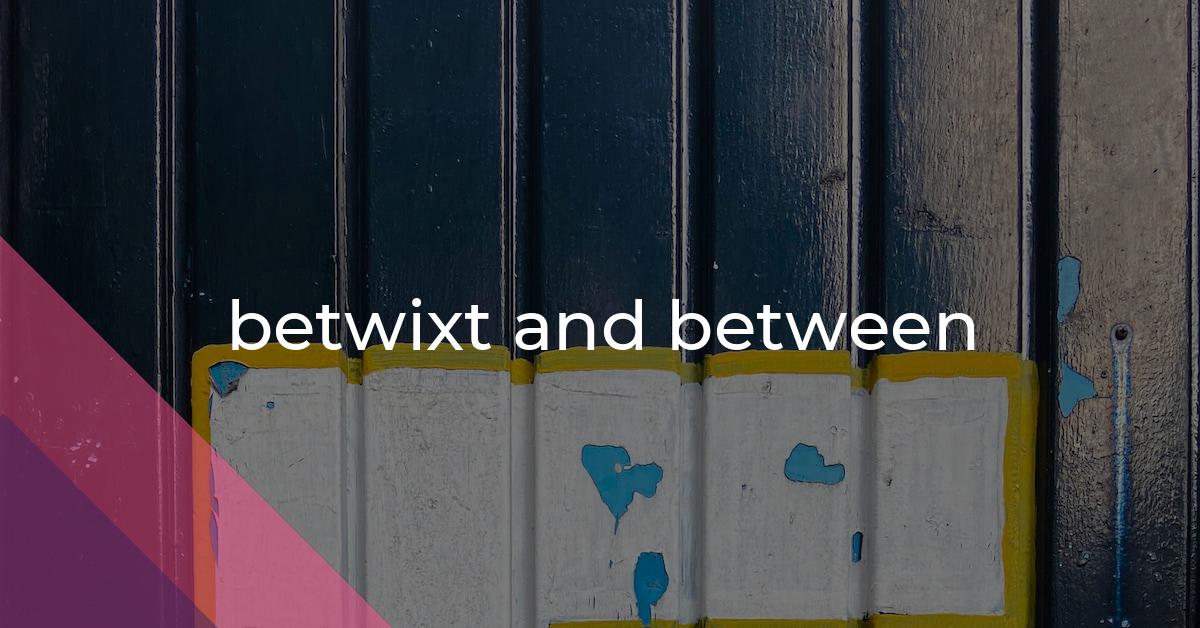betwixt and between: Idiom Meaning and Origin
What does ‘betwixt and between’ mean?
The idiom betwixt and between refers to a state of not being clearly in one situation or another, but rather being in an uncertain or ambiguous position. It can describe being undecided, stuck, or unable to make a clear choice.

Idiom Explorer
The idiom "toss-up" means a situation where it is difficult to determine or predict the outcome. It refers to a situation that is equally likely to result in either of two outcomes.
"Every which where" is an idiom used to emphasize that something or someone is located or moving in multiple directions or places. It conveys a sense of confusion, disorder, or chaos.
The idiom "double Dutch" refers to something that is confusing or difficult to understand, often because of language barriers or complex instructions.
The idiom "cut both ways" means that a situation or action can have both positive and negative consequences. It implies that something can have a double-edged effect or outcome.
The idiom "cross-purpose" refers to when two or more people have different goals or intentions, which results in conflict or confusion.
The idiom "blur the line" means to make the distinction or boundary between two things less clear or well-defined.
The idiom "between you, me, and the bedpost" means keeping a secret or confidential information shared between a select few individuals.
The idiom "between the pipes" means to be in a challenging or high-pressure situation, often referring to being in a goalkeeping position in sports such as hockey or soccer.
The idiom "between the jigs and the reels" is used to describe a confusing or chaotic situation where it is difficult to find a solution or make progress.
An analysis of the idiom "between the hammer and the anvil":
The idiom "between the hammer and the anvil" means being caught in a difficult or uncomfortable situation with no escape. It refers to being trapped between two opposing forces or pressures, much like being crushed between two hard objects.
The Undefined Middle Ground
The idiom "betwixt and between" is a phrase of British origin that dates back to the 17th century. It is used to describe a state of uncertainty or indecision. Someone who is "betwixt and between" finds themselves in a position between two opposing choices or situations. The phrase conveys a feeling of being stuck or caught in the middle, unable to make a clear decision. It implies a state of limbo or being on the fence.
The origin of the idiom can be traced back to the Middle English word "betwix," which means "between." The addition of "and" emphasizes the state of being in the middle, while "between" further clarifies the positioning. The exact origins and early usage of the idiom are not well-documented, but it has become a popular phrase in the English language.
The idiom "betwixt and between" has been used in literature, poetry, and other forms of written expression throughout history. Renowned authors such as William Shakespeare and George Eliot have used this phrase in their works. Its usage by prominent writers demonstrates its enduring relevance. It has also become a familiar phrase in colloquial speech, used in everyday conversations to succinctly describe situations where a person is torn or undecided.
There are several related idioms that convey a similar sense of being caught in the middle or facing difficult choices. One such idiom is "between a rock and a hard place." This expression describes a situation where someone is faced with two equally challenging or undesirable options. It reflects a feeling of being trapped and having to choose between two unfavorable alternatives. In essence, being "betwixt and between" is akin to being "between a rock and a hard place."
Another related idiom is "between the jigs and the reels." This phrase originates from Irish music and refers to a state of confusion or chaos. It suggests being caught between conflicting or contradictory circumstances, much like the feeling of being "betwixt and between." In both cases, there is a sense of being in a difficult or uncertain position.
Similarly, the idiom "between the devil and the deep blue sea" expresses a situation where someone is faced with two equally undesirable or dangerous choices. It conveys a feeling of being trapped and having to choose between two unfavorable alternatives. Like "betwixt and between," this idiom reflects the challenge of decision-making and the feeling of being caught in a difficult predicament.
The phrase "toss-up" is another idiom related to being "betwixt and between." It is often used to describe a situation where the outcome is uncertain or equally likely. It suggests a state of indecision or a lack of preference between two options. Much like the feeling of being "betwixt and between," a "toss-up" conveys a sense of ambiguity and an inability to make a clear decision.
The idiom "betwixt and between" reflects a state of uncertainty or indecision where someone finds themselves caught between two opposing choices or situations. Its origins can be traced back to the Middle English word "betwix." Over time, it has become a popular phrase in the English language, used in literature, poetry, and everyday conversations. Related idioms such as "between a rock and a hard place," "between the jigs and the reels," "between the devil and the deep blue sea," and "toss-up" convey similar feelings of being caught in the middle or facing difficult choices. These idioms highlight the challenges of decision-making and the human experience of being "betwixt and between."
Example usage
Examples:
- She felt betwixt and between two job offers and didn't know which one to choose.
- The house was located in a small town, betwixt and between two major cities.
- The student's answer was betwixt and between correct and incorrect, causing confusion among the teachers.
The idiom "betwixt and between" is used to describe a situation where someone is unsure or undecided between two options or possibilities. It often conveys a sense of being stuck or unable to make a clear choice. In the examples provided:
- The first example illustrates a person being torn between two job offers, unable to make a decision.
- In the second example, a house is situated in a location that is neither fully part of one major city nor the other; it is in a position between the two cities.
- The third example demonstrates a student's answer that falls somewhere in between being correct and incorrect, causing confusion and uncertainty among the teachers.
More "Uncategorized" idioms



